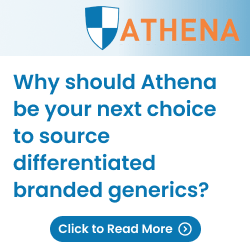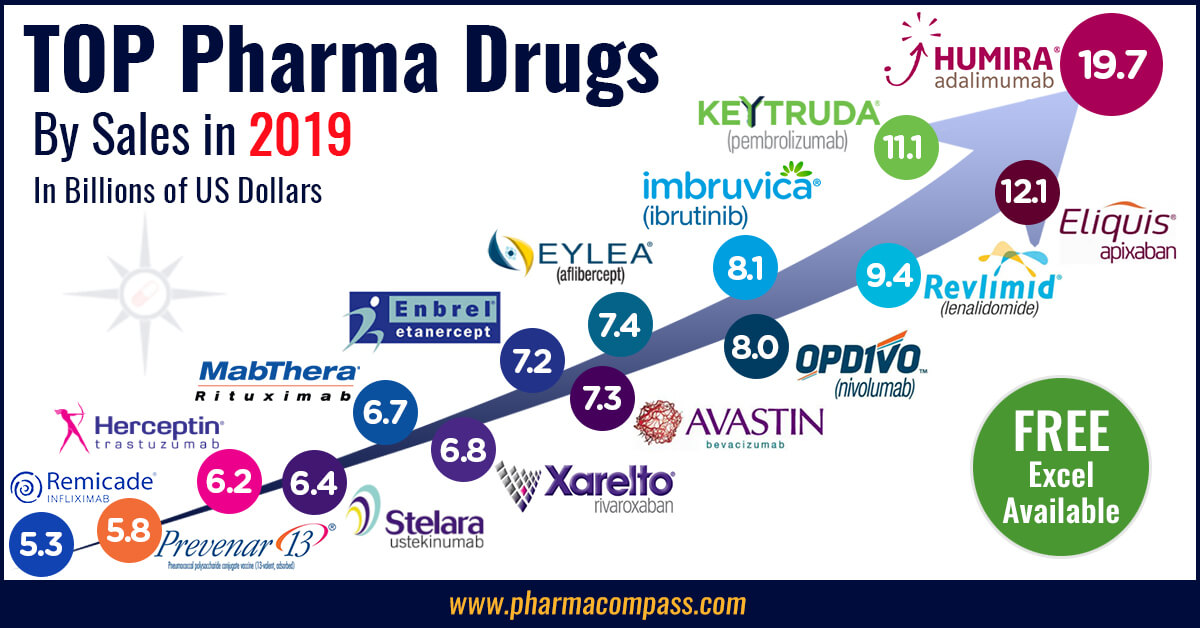Acquisitions and spin-offs dominated headlines in 2019 and the tone was set very early with Bristol-Myers Squibb acquiring
New Jersey-based cancer drug company Celgene in a US$ 74 billion deal announced on
January 3, 2019. After factoring
in debt, the deal value ballooned to about US$ 95 billion, which according
to data compiled by Refinitiv, made it the largest healthcare deal on
record.
In the summer, AbbVie Inc,
which sells the world’s best-selling drug Humira, announced its acquisition of Allergan Plc, known for Botox and other cosmetic
treatments, for US$ 63 billion. While the companies are still awaiting
regulatory approval for their deal, with US$ 49 billion in combined 2019
revenues, the merged entity would rank amongst the biggest in the industry.
View Our Interactive Dashboard on Top drugs by sales in 2019 (Free Excel Available)
The big five by pharmaceutical sales — Pfizer,
Roche, J&J, Novartis and Merck
Pfizer
continued
to lead companies by pharmaceutical sales by reporting annual 2019 revenues of
US$ 51.8 billion, a decrease of US$ 1.9 billion, or 4 percent, compared to
2018. The decline was primarily attributed to the loss of exclusivity of Lyrica in 2019,
which witnessed its sales drop from US$ 5 billion in 2018 to US$ 3.3 billion in
2019.
In 2018, Pfizer’s then incoming CEO Albert Bourla had mentioned that the company did not see the need for any large-scale M&A activity as Pfizer had “the best pipeline” in its history, which needed the company to focus on deploying its capital to keep its pipeline flowing and execute on its drug launches.
Bourla stayed true to his word and barring the acquisition of Array Biopharma for US$ 11.4 billion and a spin-off to merge Upjohn, Pfizer’s off-patent branded and generic established medicines business with
Mylan, there weren’t any other big ticket deals which were announced.
The
Upjohn-Mylan merged entity will be called Viatris and is expected to have 2020
revenues between US$ 19 and US$ 20 billion
and could outpace Teva to
become the largest generic company in the world, in term of revenues.
Novartis, which had
followed Pfizer with the second largest revenues in the pharmaceutical industry
in 2018, reported its first full year earnings after spinning off its Alcon eye
care devices business division that
had US$ 7.15 billion in 2018 sales.
In 2019,
Novartis slipped two spots in the ranking after reporting total sales of US$
47.4 billion and its CEO Vas Narasimhan continued his deal-making spree by buying New
Jersey-headquartered The Medicines Company (MedCo) for US$ 9.7
billion to acquire a late-stage cholesterol-lowering
therapy named inclisiran.
As Takeda Pharmaceutical Co was
busy in 2019 on working to reduce its debt burden incurred due to its US$ 62
billion purchase of Shire Plc, which was announced in 2018, Novartis also purchased
the eye-disease medicine, Xiidra, from the Japanese drugmaker for US$ 5.3 billion.
Novartis’ management also spent a considerable part of 2019 dealing with data-integrity concerns which emerged from its 2018 buyout of AveXis, the
gene-therapy maker Novartis had acquired for US$ 8.7 billion.
The deal gave Novartis rights to Zolgensma,
a novel treatment intended for children less than two years of age with the
most severe form of spinal muscular atrophy (SMA). Priced at US$ 2.1 million,
Zolgensma is currently the world’s most expensive drug.
However,
in a shocking announcement, a month after approving the drug, the US Food and
Drug Administration (FDA) issued a press release on
data accuracy issues as the agency was informed by AveXis that
its personnel had manipulated data which
the FDA used to evaluate product comparability and nonclinical (animal)
pharmacology as part of the biologics license application (BLA), which was
submitted and reviewed by the FDA.
With US$
50.0 billion (CHF 48.5 billion) in annual pharmaceutical sales, Swiss drugmaker
Roche came in at number two position in 2019
as its sales grew 11 percent driven by
its multiple sclerosis medicine Ocrevus, haemophilia drug Hemlibra and cancer medicines Tecentriq and Perjeta.
Roche’s newly introduced medicines generated US$ 5.53 billion (CHF 5.4 billion) in growth, helping offset the impact of the competition from biosimilars for its three best-selling drugs MabThera/Rituxan, Herceptin and Avastin.
In late 2019, after months of increased
antitrust scrutiny, Roche completed
its US$ 5.1 billion acquisition of Spark Therapeutics to strengthen its presence in
gene therapy.
Last year, J&J reported almost flat worldwide sales of US$ 82.1 billion. J&J’s pharmaceutical division generated US$ 42.20 billion and its medical devices and consumer health divisions brought in US$ 25.96 billion and US$ 13.89 billion respectively.
Since J&J’s consumer health division sells analgesics, digestive health along with beauty and oral care products, the US$ 5.43 billion in consumer health sales from over-the-counter drugs and women’s health products was only used in our assessment of J&J’s total pharmaceutical revenues. With combined pharmaceutical sales of US$ 47.63 billion, J&J made it to number three on our list.
While the sales of products like Stelara, Darzalex, Imbruvica, Invega Sustenna drove J&J’s pharmaceutical business to grow by 4 percent over 2018, the firm had to contend with generic competition against key revenue contributors Remicade and Zytiga.
US-headquartered Merck, which is known as
MSD (short for Merck Sharp & Dohme) outside the United States and
Canada, is set to significantly move up the rankings next year fueled by its
cancer drug Keytruda, which witnessed a 55
percent increase in sales to US$ 11.1 billion.
Merck reported total revenues of US$ 41.75 billion and also
announced it will spin off its women’s health drugs,
biosimilar drugs and older products to create a new pharmaceutical
company with US$ 6.5 billion in annual revenues.
The firm had anticipated 2020 sales between US$ 48.8 billion and US$ 50.3 billion however this week it announced that the coronavirus pandemic will reduce 2020 sales by more than $2 billion.
View Our Interactive Dashboard on Top drugs by sales in 2019 (Free Excel Available)
Humira holds on to remain world’s best-selling drug
AbbVie’s acquisition of Allergan comes as the firm faces the expiration of patent protection for Humira, which brought in a staggering US$ 19.2 billion in sales last year for
the company. AbbVie has failed to successfully acquire or develop a major new
product to replace the sales generated by its flagship drug.
In 2019, Humira’s US revenues increased 8.6 percent to US$ 14.86 billion while internationally, due
to biosimilar competition, the sales dropped 31.1 percent to US$ 4.30 billion.
Bristol Myers Squibb’s Eliquis, which is also marketed by Pfizer, maintained its number two position
and posted total sales of US$ 12.1 billion, a 23 percent increase over 2018.
While Bristol Myers Squibb’s immunotherapy treatment Opdivo, sold in partnership with Ono in Japan, saw sales increase from US$ 7.57 billion to US$ 8.0 billion, the growth paled in comparison to the US$ 3.9
billion revenue increase of Opdivo’s key immunotherapy competitor Merck’s Keytruda.
Keytruda took the number three spot in drug sales that
previously belonged to Celgene’s Revlimid, which witnessed a sales decline from US$ 9.69 billion to US$ 9.4 billion.
Cancer treatment Imbruvica, which is marketed
by J&J and AbbVie, witnessed a 30 percent increase in sales. With US$ 8.1
billion in 2019 revenues, it took the number five position.
View Our Interactive Dashboard on Top drugs by sales in 2019 (Free Excel Available)
Vaccines – Covid-19 turns competitors into partners
This year has been dominated by the single biggest health emergency in years — the novel coronavirus (Covid-19) pandemic. As drugs continue to fail to meet expectations, vaccine development has received a lot of attention.
GSK reported the highest vaccine sales of all drugmakers with
total sales of US$ 8.4 billion (GBP 7.16 billion), a significant portion of its
total sales of US$ 41.8 billion (GBP 33.754 billion).
US-based Merck’s vaccine division also reported a significant increase in sales to US$ 8.0 billion and in 2019 received FDA and EU approval to market its Ebola vaccine Ervebo.
This is the first FDA-authorized vaccine against the deadly virus which causes
hemorrhagic fever and spreads from person to person through direct contact with
body fluids.
Pfizer and Sanofi also reported an increase in their vaccine sales to US$ 6.4
billion and US$ 6.2 billion respectively and the Covid-19 pandemic has recently
pushed drugmakers to move faster than ever before and has also converted
competitors into partners.
In a rare move, drug behemoths — Sanofi and GlaxoSmithKline (GSK) —joined hands to develop a vaccine for the novel coronavirus.
The two companies plan to start human trials
in the second half of this year, and if things go right, they will file
for potential approvals by the second half of 2021.
View Our Interactive Dashboard on Top drugs by sales in 2019 (Free Excel Available)
Our view
Covid-19 has brought the world economy to a grinding halt and shifted the global attention to the pharmaceutical industry’s capability to deliver solutions to address this pandemic.
Our compilation shows that vaccines and drugs
for infectious diseases currently form a tiny fraction of the total sales of
pharmaceutical companies and few drugs against infectious diseases rank high on
the sales list.
This could well explain the limited range of
options currently available to fight Covid-19. With the pandemic currently infecting
over 3 million people spread across more than 200 countries, we can safely
conclude that the scenario in 2020 will change substantially. And so should our
compilation of top drugs for the year.
View Our Interactive Dashboard on Top drugs by sales in 2019 (Free Excel Available)
Impressions: 54754
This week, PharmaCompass brings you a compilation of the Drug Master Files (DMFs) updates at the US Food and Drug Administration (FDA) over the past two quarters. These applications provide an overview of the products active pharmaceutical ingredient (API) manufacturers are investing in. And, they also give a sneak preview into the next possible first-to-file (FTF) generic challenges to patented drugs.
Here are some key findings from our compilation of the FDA’s DMF updates over the second and third quarter of 2016, details of which were provided in July and October:
India leads
the pack, as the number of filings remain the same
Over the period, there were a total of 379 updates of DMFs at the FDA. This number
indicates a pace in filings that is nearly the same as the previous quarters.
We had seen 180 DMFs updates in the last quarter (Q4) of 2015 and 190 in the first quarter (Q1) of 2016.
During the last
two quarters, the DMF updates were led by Indian companies, such as Macleods Pharmaceuticals (14 DMFs), MSN Labs (13 DMFs), Hetero
(12 DMFs), Lupin (9 DMFs), Cipla and Biophore. The other prominent companies were Mylan and Teva.
Companies
with compliance issues stay away
Unlike previous
quarters, where
companies with compliance problems continued to submit DMFs, the last two
quarters were slightly different, since companies like Zhejiang Hisun and Ipca
Laboratories did not submit DMFs.
However,
Emcure Pharmaceuticals — whose Pune facility was inspected by
the FDA last year and a warning letter was issued to the company for violations of current good manufacturing practices (cGMPs) in March this year — submitted one DMF (for Phytonadione)
While
China shut down antibiotic manufacturing in the Shijiazhuang
city, raising concerns about the global supply chain’s dependence on China, Sinopharm Weiqida Datong
Pharmaceutical, located about 300 kilometers away from Shijiazhuang, filed DMFs for the key building blocks of antibiotic manufacturing — 6-APA and 7-ACA.
Once
again, this filing reinforces the dependence of global
antibiotic manufacturing on China.
Click here to view all the updates of the second and third quarter of 2016 (Excel version available) for FREE!
Imminent FTF challenges
The
FTF challenges to Alvimopan Dihydrate (Merck’s Entereg), Apremilast (Celgene’s Otezla), Bosutinib (Pfizer’s Bosulib), Daclatasvir
Dihydrochloride (Bristol-Myer
Squibb’s Daklinza), Elvitegravir (an ingredient in Gilead’s Vitekta,
Stribild, Genvoya), Ibrutinib (AbbVie’s
Imbruvica), Ospemifene (Shionogi’s Osphena), Perampanel (Eisai’s Fycompa), Pomalidomide (Celgene’s Pomalyst), Regorafenib (Bayer’s Stivarga), Tofacitinib (Pfizer’s Xeljanz) and
Vortioxetine
Hydrobromide (Takeda’s Trintellix) seem to be imminent in
view of the recent filings of DMFs.
Roche’s 2014 acquisition of
InterMune for US $ 8.3 billion to gain rights to Esbriet (pirfenidone)
is likely to come under attack as three more DMFs were submitted during the
period under review.
The ink wasn’t dry on the deal papers of Pfizer’s US $1 4 billion acquisition of Medivation in August this year, when two more companies — Watson Pharma (now Allergan) and Scinopharm — submitted filings for Enzalutamide, the product for
which Pfizer paid all that money. This takes the total number of US submissions
for this product to seven.
Apixaban and Canagliflozin are most actively filed products
The most actively updated DMFs in the past six months were for the APIs of Bristol-Myer Squibb’s new-age anticoagulant Eliquis (Apixaban)
and Johnson & Johnson’s diabetes treatment Invokana (Canagliflozin). Sixteen DMFs were submitted for Apixaban along with nine for
Canagliflozin.
Products
like Dimethyl Fumarate and Teriflunomide — which were the
most frequently filed DMFs in our previous reports — continued to see vigorous filing activity.
Synbias Pharma made a submission
for Nelarabine, the only
submission for a Novartis product that was approved in 2005
and for which the only listed patent is expiring in June 2017. Similarly DSM’s submission of Dexpanthenol is the only DMF
listed for a product used in a variety of injectable and intravenous solution
products.
Established
pharmaceutical companies like Quimica Sintetica and Piramal Healthcare made submissions for products — Benznidazole and Norprostol — which are currently not approved in the United States, indicating the possibility of development projects being underway.
Our view
With drug filings ranging from multiple FTFs to cannabis derivatives,
updates over the two quarters have shown that regardless of the compliance
news, activity in the API industry is extremely robust.
You can view the PharmaCompass compilation of
the new DMF filings by clicking here or simply by sending us an email to get
your own Excel version of the new submissions.
Click here to view all the updates of the second and third quarter of 2016 (Excel version available) for FREE!
Impressions: 4466
PharmaCompass has assessed the second quarter US Drug Master
File (DMFs) filings. In our view, with five potential first-to-file (FTF)
applications along with another five DMFs challenging markets that have been
monopolized for decades, the pharmaceutical industry in the United States
should brace itself for some serious shakeups. Unlike the first
quarter of 2015 where 241 new DMF filings were listed on the USFDA site,
this quarter saw a reduction of almost 35 percent in the DMFs filed. As DMFs
form a critical part of the regulatory submissions made by generics to
challenge innovator companies, a reduction in filings, in the recent quarter,
seems to bear no correlation with the disruption the market will potentially
witness in times to come. The ‘first-to-file’ disruptors Profits in the generic pharmaceutical business are highly dependent on how quickly a drug is introduced in the market. The ‘first-to-file’ generic is a coveted position, since the company is legally granted
a 180-day period of market exclusivity, where no other generic can be in the
market. This six month exclusivity invariably leads to windfall gains for the
company.This quarter DMFs were received by the FDA, which could potentially drive the first-to-file challenges against J&J’s blockbuster Inovkana (canagliflozin), Eisai’s Belviq (lorcaserin
hydrochloride), Incyte’s Jakavi (ruxolitinib
phosphate), Celgene’s Pomalyst (pomalidomide) and Akorn’s Zioptan (tafluprost).However, given the complexities involved in bringing a
generic product to market, the first DMF filing does not always result in the
first generic challenge to the brand drug. The second DMFs filed for a product
are also strong contenders which must not be ignored. For example, Glenmark
recently filed their DMF for tofacitinib,
almost 18 months after serial-DMF filing by MSN
Pharmaceuticals. But Glenmark
has moved ahead by already getting their DMF reviewed by the FDA. Similarly, while Alp Pharma Beijing’s dapagliflozin, Perrigo’s ferric citrate and Amino Chemicals’ miglustat
are the second DMFs to be received by the FDA, the innovator should start
counting the days before they are plagued by generic challengers. Exclusively
not-patentedFor several years, Indian companies have been leading many
first-to-file generic challenges in the United States. However, as they have
scaled up in size, the same companies have also obtained rights to some
exclusive markets in the United States; either through acquisitions or
alliances. Sun Pharmaceutical’s US
$ 230 million acquisition of dermatology specialist Dusa was triggered by the successful sales of Dusa’s photo-chemotherapy treatment, Levulan. German Midas Pharma GmbH’s filing will not only subject Sun’s market domination to generic competition, the fact that there are six other DMFs filed for this product (of which none of the filings have come from Indian or Chinese companies) indicates a change in the way the industry is beginning to operate. Like Sun Pharmaceutical’s monopoly of Levulan, Dr. Reddy’s has enjoyed no competition for their topical treatment, Cloderm (clocortolone
pivalate) since 2011 when they purchased the rights for the product by
making an
upfront payment of US $ 36 million to Canadian, Valeant Pharmaceuticals. Dr. Reddy’s needs to start monitoring the progress of Italian Trifarma’s filing since this is the fifth time a DMF for this product has been received by the FDA.Indian companies aside, Aspen’s Leukeran, Bausch & Lomb’s Zirgan, Mission Pharmaceuticals’ Thiola and GSK’s topical treatment Abreva have
all marketed their products without any competition. The DMF filings of this
quarter indicate that generics have narrowed in on the profits being made and
the market dynamics for these products will change in the future. Down, but not outIntriguingly, companies like Apotex
Pharmachem, Emcure
Pharmaceuticals and Global Calcium
are currently on the FDA Import Alert list and banned from exporting products
to the United States since they did not operate in
conformity with the current good manufacturing practices (GMP's). However, these companies are definitely optimistic about
their future since they have all filed new DMFs this quarter. It remains to be
seen if the bans will get lifted in the near future.This quarter also saw Dr. Reddy’s get creative in their challenge to Japanese Astellas Pharma’s leaky bladder treatment, Myrbetriq (mirabegron).
After having filed a DMF last year, they re-filed again recently, with a
different polymorphic form, to potentially circumvent the patents around this
product. Our supportGeneric pharmaceutical companies are continuously looking
for opportunities where they can get the maximum possible market share in the
fastest way possible. While the number of manufacturers of active pharmaceutical
ingredients (APIs) keep increasing, we are also witnessing an increase in the cost
of regulatory support required to sustain the production of these APIs. The industry is becoming more challenging – identifying target markets is becoming a science which requires high-level management focus. In order to help you, PharmaCompass will share its compilation of this quarter’s DMF filing list. Just send
us an email by clicking here and we’re happy to support you in every possible way.Last week, the FDA also announced the fee dues (as on
October 1, 2015), as per the Generic Drug User Fee Act (GDUFA). We are sharing
the amounts due, in case you have not been able to access this information.
FISCAL YEAR AND FEE TYPE
2014 (Rate)
2015 (Rate)
$ & %
Difference from previous year
Abbreviated New Drug Application
$63,860
$58,730
-$5,130 (-8.0%)
Prior Approval Supplement
$31,930
$29,370
-$2,560 (-8.0%)
Drug Master File
$31,460
$26,720
-$4,740 (-15.1%)
Finished Dosage Form Facility
$220,152 (Domestic)
$247,717 (Domestic)
$27,565 (12.5%)
$235,152 (Foreign)
$262,717 (Foreign)
Active Pharmaceutical Ingredient
Facility
$34,515 (Domestic)
$41,926 (Domestic)
$7,411 (21.5%)
$49,515 (Foreign)
$56,926 (Foreign)
Impressions: 5140















